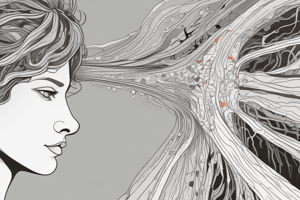Podcast
Questions and Answers
What assessment finding is MOST indicative of the 'Extension' classification in treatment-based classification (TBC) according to Fritz 2007?
What assessment finding is MOST indicative of the 'Extension' classification in treatment-based classification (TBC) according to Fritz 2007?
- Age greater than 50 years.
- Visible frontal deviation of the shoulders.
- Symptoms distal to the buttock. (correct)
- Symptoms of nerve root compression.
Which intervention strategy is NOT typically associated with the 'Flexion' classification in the Fritz 2007 treatment-based classification system?
Which intervention strategy is NOT typically associated with the 'Flexion' classification in the Fritz 2007 treatment-based classification system?
- Manual therapy of the spine and/or lower extremities.
- End-range extension exercises. (correct)
- Therapeutic exercises to address strength or flexibility impairments.
- Body-weight support treadmill ambulation.
A patient presents with a visible frontal deviation of the shoulders relative to the pelvis. According to Fritz 2007, which treatment-based classification subgroup is MOST appropriate?
A patient presents with a visible frontal deviation of the shoulders relative to the pelvis. According to Fritz 2007, which treatment-based classification subgroup is MOST appropriate?
- Flexion
- Extension
- Lateral shift (correct)
- Traction
Which of the following is a PRIMARY selection criterion for the 'Traction' classification within the Fritz 2007 treatment-based classification?
Which of the following is a PRIMARY selection criterion for the 'Traction' classification within the Fritz 2007 treatment-based classification?
According to Alrwaily 2016, which of the following represents a shift in terminology and approach compared to the Fritz 2007 treatment-based classification?
According to Alrwaily 2016, which of the following represents a shift in terminology and approach compared to the Fritz 2007 treatment-based classification?
Which of the following intervention subgroups is emphasized in the Alrwaily 2016 update to treatment-based classification, reflecting a broader approach to patient management?
Which of the following intervention subgroups is emphasized in the Alrwaily 2016 update to treatment-based classification, reflecting a broader approach to patient management?
What is the PRIMARY purpose of the STarT Back Screening Tool, as mentioned in the provided text?
What is the PRIMARY purpose of the STarT Back Screening Tool, as mentioned in the provided text?
In contrast to the Fritz 2007 classification, the Alrwaily 2016 update emphasizes that classification is primarily based on:
In contrast to the Fritz 2007 classification, the Alrwaily 2016 update emphasizes that classification is primarily based on:
What is a primary goal of utilizing a Treatment Based Classification (TBC) system for managing lumbopelvic pain?
What is a primary goal of utilizing a Treatment Based Classification (TBC) system for managing lumbopelvic pain?
Delitto's 1995 Treatment Based Classification system primarily focused on which factor for patient classification?
Delitto's 1995 Treatment Based Classification system primarily focused on which factor for patient classification?
How did Fritz's 2007 update to the Treatment Based Classification system differ most significantly from Delitto's 1995 version?
How did Fritz's 2007 update to the Treatment Based Classification system differ most significantly from Delitto's 1995 version?
What is the initial step in developing a Treatment Clinical Prediction Rule (CPR)?
What is the initial step in developing a Treatment Clinical Prediction Rule (CPR)?
Which of the following is NOT a typical selection criterion for the Manipulation classification within Fritz's 2007 TBC system?
Which of the following is NOT a typical selection criterion for the Manipulation classification within Fritz's 2007 TBC system?
According to the provided material, which of the following is a primary intervention strategy for the 'Stabilization' classification of lumbopelvic pain?
According to the provided material, which of the following is a primary intervention strategy for the 'Stabilization' classification of lumbopelvic pain?
Which of the following best describes the 'Specific Exercise' classification (though not detailed in the provided text, based on general TBC principles)?
Which of the following best describes the 'Specific Exercise' classification (though not detailed in the provided text, based on general TBC principles)?
What statistical method is used in the development of Treatment Clinical Prediction Rules (CPRs) to identify significant factors?
What statistical method is used in the development of Treatment Clinical Prediction Rules (CPRs) to identify significant factors?
Flashcards
Fritz's Classification System
Fritz's Classification System
A classification system for low back pain that categorizes patients based on their symptoms and the direction in which their symptoms move with specific movements.
Extension-Based Back Pain
Extension-Based Back Pain
A common subtype of mechanical low back pain characterized by pain that worsens with extension (leaning back) and improves with flexion (bending forward).
Flexion-Based Back Pain
Flexion-Based Back Pain
A subtype of mechanical low back pain characterized by pain that worsens with flexion (bending forward) and improves with extension (leaning back).
Lateral Shift-Based Back Pain
Lateral Shift-Based Back Pain
Signup and view all the flashcards
Traction for Back Pain
Traction for Back Pain
Signup and view all the flashcards
Alrwaily's Classification System
Alrwaily's Classification System
Signup and view all the flashcards
STarT Back Screening Tool
STarT Back Screening Tool
Signup and view all the flashcards
Alrwaily's Updated Classification System
Alrwaily's Updated Classification System
Signup and view all the flashcards
Treatment Based Classification (TBC)
Treatment Based Classification (TBC)
Signup and view all the flashcards
Clinical Prediction Rules (CPRs)
Clinical Prediction Rules (CPRs)
Signup and view all the flashcards
Manipulation (TBC)
Manipulation (TBC)
Signup and view all the flashcards
Stabilization (TBC)
Stabilization (TBC)
Signup and view all the flashcards
Specific Exercise (TBC)
Specific Exercise (TBC)
Signup and view all the flashcards
Traction (TBC)
Traction (TBC)
Signup and view all the flashcards
Delitto's 1995 TBC System
Delitto's 1995 TBC System
Signup and view all the flashcards
Fritz's 2007 TBC System
Fritz's 2007 TBC System
Signup and view all the flashcards
Study Notes
Treatment Based Classification of Lumbopelvic Pain
- Treatment-based classification systems have evolved over the past 30 years
- The goal is to match patients to appropriate treatments
- The aim is to improve patient outcomes
- The aim is to improve research quality
- Studies show that matching interventions to patients' classifications leads to superior outcomes
Objectives
- Demonstrate understanding of the Treatment Based Classification system in the management of lumbopelvic pain.
Treatment Based Classification
- Match patients with appropriate interventions to improve outcomes
- Reduce heterogeneity in research to allow for better comparison of interventions
- Make more powerful recommendations and move away from the pathoanatomical model (Delitto 1995, Fritz 2007, Alrwaily 2016).
TBC - Delitto 1995
- Organized into 3 broad levels (consultation, physical therapy, referral)
- Focused on triage and classifying based on symptom severity (acute, chronic) rather than stage.
- First level classification decides which patients can be treated by physical therapists independently verses those needing multidisciplinary management or referral to another healthcare provider
- Staging criteria uses Oswestry scores to approximate clinical judgment of functional limitations (eg: sitting, standing, walking). Activities of daily living (ADL), not solely on self-reported limitations
- There are three stages of classification (I, II, III) with different intervention focus and goals
TBC - Fritz 2007
- Updated based on research since 1995
- Focus on examination findings, less on triage or symptom severity
- Clinical prediction rules (CPRs) are used in treatment planning
- Tools to make clinical decision making in treatment and diagnosis
- Developed by recruiting patients, conducting standardized history and physical exams, giving everyone the treatment, and statistically determining which factors play the largest role in outcome.
Classifications Based on Fritz 2007
- Manipulation:
- Recent onset of symptoms (<16 days)
- No distal symptoms (below the knee)
- Low pain questionnaire (FABQ(W) score <19)
- Hypomobility of lumbar spine (e.g., segmental limitation)
- Hip internal rotation ROM > 35 degrees
- Interventions: HVLAT (thrust) of the lumbopelvic region and AROM exercises.
- Stabilization:
- Age < 40 years
- Greater general flexibility (average SLR >91°)
- Instability "catch" (aberrant motion) during trunk flexion/extension
- Prone instability test (+ results)
- Interventions: Isolated and co-contraction of segmental stabilizing muscles; strengthening large stabilizing muscles; improve function of other stabilizing mechanisms; hydraulic cylinder
- Specific Exercises:
- Extension: Sx distal to buttock, centralizes with lumbar extension, peripheralizes with lumbar flexion, directional preference for extension, Age > 50 years, imaging evidence of lumbar spinal stenosis. Interventions include: end-range extension exercises, manual therapy, flexibility exercises, body-weight support, and avoidance of flexed positions and flexion activities.
- Flexion: Directional preference for flexion, imaging evidence of lumbar spinal stenosis, visible frontal deviation of the shoulders relative to the pelvis, directional preference for lateral translation movements. Interventions include: manual therapy, flexibility exercises, body-weight support, and avoidance of flexed positions and flexion activities.
- Lateral shift: Visible frontal deviation of shoulders relative to pelvis, directional preference for lateral translation movements of the pelvis. Interventions include: exercises to correct lateral shift, mechanical, or autotraction.
- Traction:
- Sx of nerve root compression, no centralization with movements. Interventions include: manual or motorized traction.
TBC - Alrwaily 2016
- Updated terminology to align with APTA guidelines
- Included psychosocial factors in treatment
- Restored triage level and broadened intervention subgroups: symptom modulation, movement control, and functional optimization
- Classification based on symptom severity, like earlier models, but also incorporates clinical findings
Triage
- Medical management
- Rehabilitation management
- Self-care management
STarT Back
- Subgroups for Targeted Treatment (STarT) Back Screening Tool
- Attempts to stratify risk of poor outcomes for patients with persistent disabling pain.
TBC - Alrwaily 2016 - Matching Criteria
- This table describes matching criteria for the rehabilitation provider
- Factors include patient pain and disability rating, clinical status, psychosocial status, and comorbidities. The table also classifies each aspect for symptom modulation, movement control, and functional optimization.
Questions
Studying That Suits You
Use AI to generate personalized quizzes and flashcards to suit your learning preferences.




